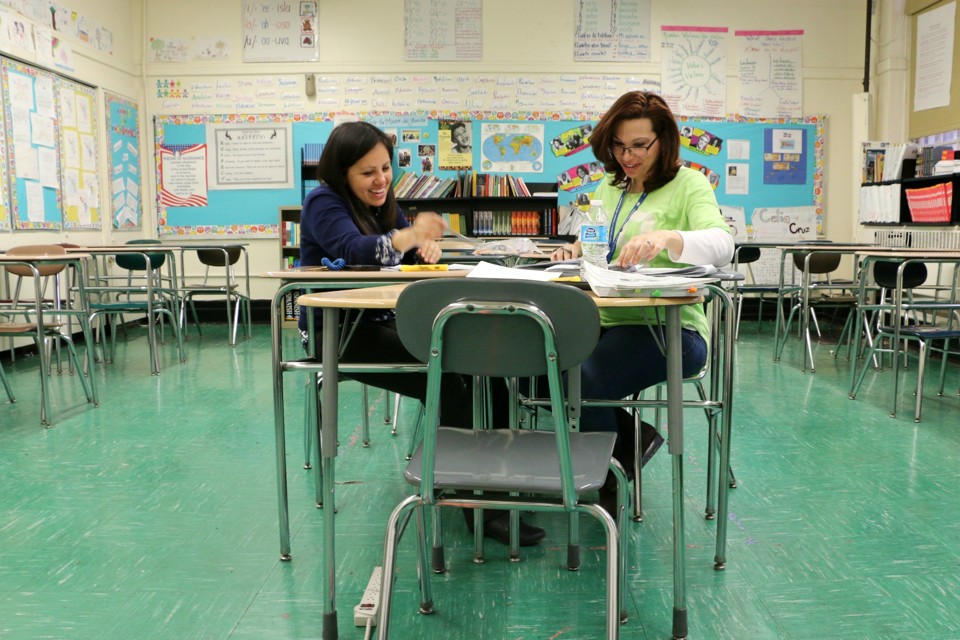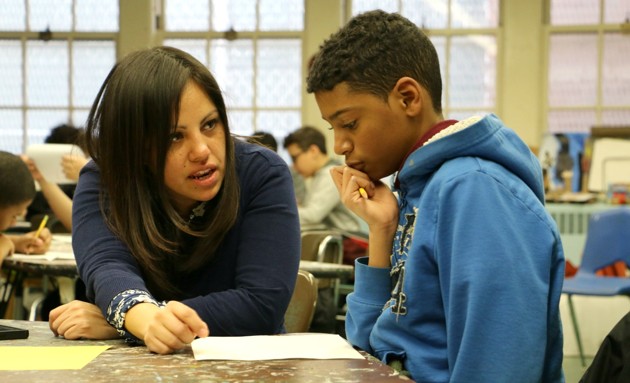Why Non-Academic Needs Matter, Too
A day in the life of a new kind of educator who’s tasked with revitalizing one of New York City's campuses by supporting kids' health, attendance, and family lives

Fiorella Guevara, left, looks at student writing samples with a bilingual teacher at M.S. 50 in Williamsburg
Around 4 p.m. on a recent Friday, Fiorella Guevara got around to eating her lunch. Then she leaned back in the student-sized chair where she was sitting in an empty classroom and let out a long sigh. “Oh man, I’m tired,” said Guevara, the new community-school director at M.S. 50 in Brooklyn’s Williamsburg neighborhood. “This is why I never sit down for too long.”
Instead, she bounds from room to room, checking on the classes she oversees, meeting with the principal or calling up parents, pausing just long enough to hug one of the students whose affection she’s earned in her few months on the job.
Community-school directors like Guevara play a key role in Mayor Bill de Blasio’s plan to revitalize 94 of New York City’s low-performing schools—including M.S. 50, where just one in 10 students passed last year’s state English tests, and 40 percent of students are considered chronically absent. The mission of community schools is to treat students’ physical or emotional ailments so they can focus on learning. Each director is responsible for coordinating the activities, social services, and parent workshops that the mayor is hoping will help set the schools on a different path.
“I truly, 100 percent believe in community schools,” she said.
Chalkbeat, which produced this story, stopped by M.S. 50 recently to see how the job really worked. Here are highlights from Guevara’s day.
Guevara’s role requires quickly switching from nurse to counselor to administrator. When she walked into a bilingual class, where the children were eating a lunch of chicken and rice, she found a boy who had hurt his ankle. In fluent Spanish, she told him to get some ice and elevate it. Then she read a letter a girl had received from the health department saying she was missing a mandatory physical exam, though the girl said she’d already had it. Guevara promised to investigate.
Next, she dropped by a peer-mediation class that she started at the school this year. She listened in as the students, munching on pizza, discussed the need to stay neutral when settling disputes between classmates. Then Guevara, whose iPhone is always on hand, took a snapshot of the attendance list: A few students were missing. “My day-to-day is ensuring that the vision we’ve laid out is going,” she expl
ained. “And also troubleshooting when there’s something that’s not going right with the plan.”
Later, when she stepped into the crowded hallway as students returned from lunch, she hugged a girl, told a boy to spit out his gum, then pulled aside a student who had skipped the peer-mediation class. Without scolding, Guevara told her how important it is to show up for class, then sent her on her way. “Alright kids,” How Bill de Blasio Is Using 'Community Schools' to Improve Education in New York City - The Atlantic:

